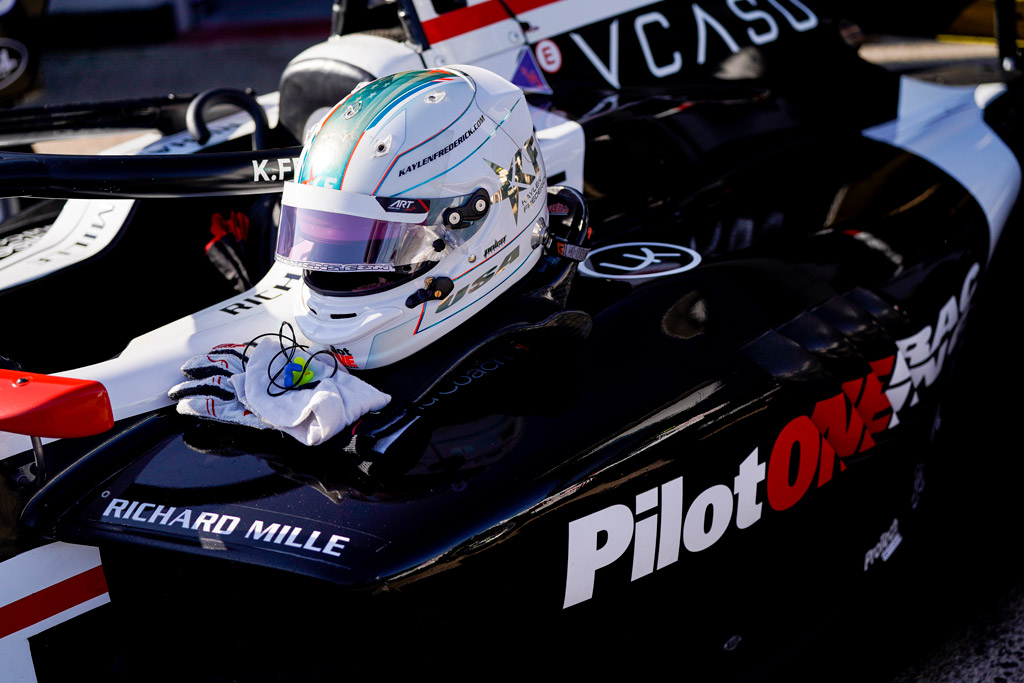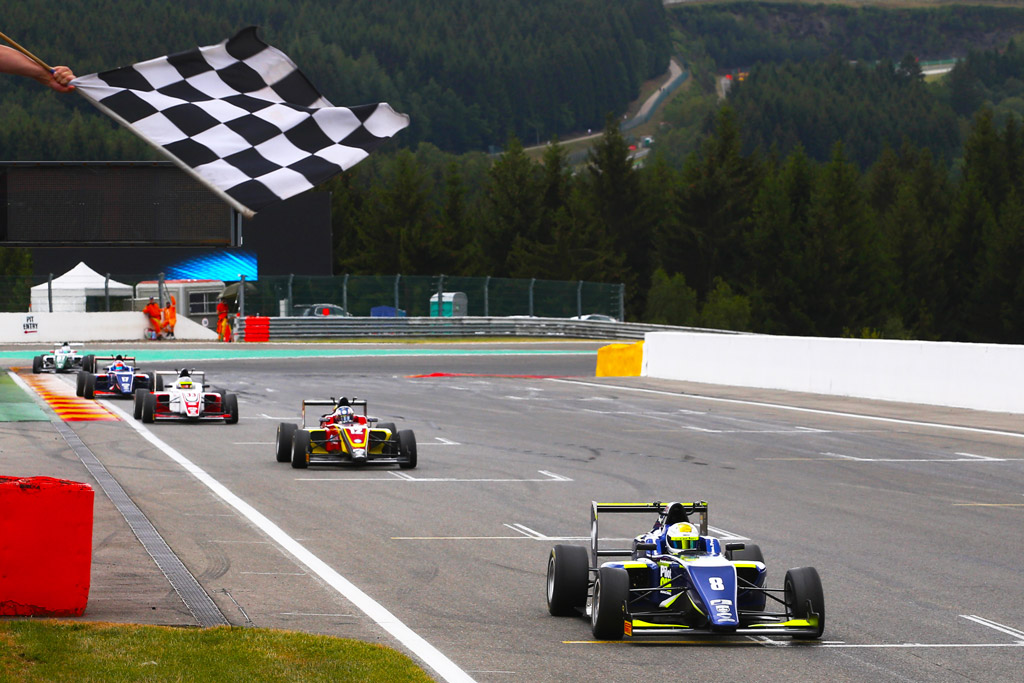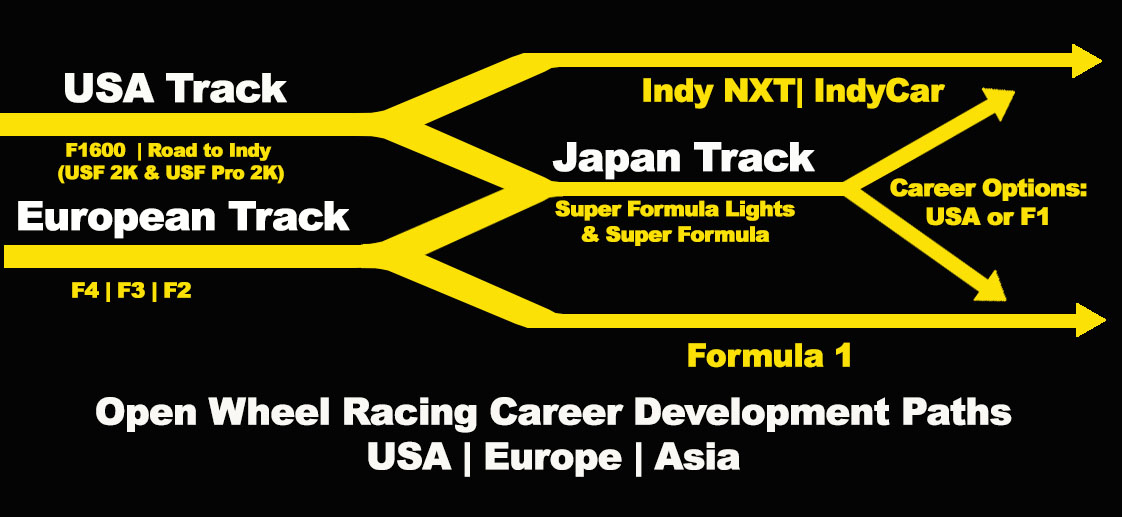Open-wheel race cars offer the highest development path and breeding grounds for car racing as they are the lightest cars to drive, significantly powered, and series are available at the best tracks in the world. The overview that follows below will highlight the career alternatives open at the top of the pyramid, in the pinnacle of open-wheel racing worldwide. A driving career in open-wheel racing can be broken down in early, middle, and later career development paths. Early careers are focused on karting (see ‘Driver Development’ https://pilotoneracing.com/driver-development/ ). A successful mid-career driver will progress first through open-wheel cars without wings (mechanical grip only), followed by introductory winged cars with downforce. Beyond these introductory series a driver steps into the top levels of racing in Europe, USA, and Asia, and competes with driver talent pool at a world-class level. Although separate series, these three arenas enable development in different regions of the world with different tracks, cars, tires, and teams. The three career paths can allow drivers to jump from one to another while continuing an upwards career trajectory, and therefore a driver must be vigilant for opportunities in any of these series at any time. A brief overview of the series and opportunities is highlighted below.
Formula 1
Formula 1 is recognized by most as the apex of open-wheel racing worldwide. With ten teams and twenty drivers total, the competition for a seat is fierce. Formula 1 cars are costly to develop, have the fastest lap times, tremendous downforce, and are powered by four-stroke 1.6-liter V6 engines with a hybrid electric power source with astonishing levels of efficiency and power output with a combined 1,000 HP. F1 cars weigh 1,754 pounds. Formula 1 is overseen by the Federation Internationale de l’Automobile (FIA), the governing body for world motor sport and the federation of leading world motorsport organizations. F1 teams have a cost ceiling of $135 million for two cars per team.
To get to F1, the FIA favors its own ladder series for career drivers, namely F4, F3, and F2. F4 and F3 are available in regional series (Europe, Great Britain, Asia, China, & USA), and prepare drivers for the FIA F3 international series that travels with the F1 calendar. F2 however is only available at the international level. The competition in FIA F3 & F2 is fierce, and it is often seen that the champions are unable to land a seat in F1 as they are not available. However top-level drivers in these series easily transition to other strong series such as Japan Super Formula, IndyCar, FormulaE, or endurance series.
USA: Indy NXT & IndyCar Series
Quick Glance: USA | The Indy NXT Series
Indy NXT is the entry level and feeder series for IndyCar. With a typical field of 18-20 drivers, competition is substantial in a series contested mostly by US and European drivers. The NXT series is owned by IndyCar and allows drivers to be followed firsthand by the teams of IndyCar, and hopefully opening doors to this top level of USA open wheel racing series. With a 14-race calendar, venues include road courses (8), ovals (3), and street tracks (3). Races in NXT may be viewed live via the NXT website or IndyCar commercial broadcasts.
At the top of USA racing is IndyCar with a standardized Dallara chassis and power source, and Firestone tires. Running a 2.2-liter turbocharged V6, IndyCars weigh 1,590 – 1,630 pounds depending on the track (lightest on the speedways). An IndyCar produces 550 – 700 horsepower and has a top speed of 240 mph. Engine manufacturers currently include Honda & Chevrolet. Indycar programs run $10 million per car.
Japan | The Super Formula and Super Formula Lights Series
Quick Glance: Japan | The Super Formula and Super Formula Lights Series
The top levels of Japan open-wheel racing series are Super Formula Lights (SFL) and Super Formula (SF). Considered the strongest open wheel series in Asia, the Super Formula is rated highly in the motorsports racing world and has produced drivers that went on further to compete in F2, F1, and IndyCar. The SF Lights series is the entry level and feeder series to Super Formula. Both SFL and SF are driven predominantly by Japanese drivers with years of experience on the six tracks of the series. This raises the challenge to drivers from other areas of the world, as they need to quickly come to terms with new tracks, tires, teams, and cars. On the car side, the Dallara 320 chassis of SF Lights is a ‘driver’s car’, also used in the Euro-Formula Open Series and closely related to the Indy NXT Dallara. Notably, both the SFL and SF cars are rated highly by all drivers as beautiful cars to drive due to their lightweight (1,268 pounds), beautifully balanced chassis, and significant downforce with a 2-liter inline 4-cylinder engines with 240 horsepower.
As a racing series, Super Formula Lights (SFL) is an excellent pre-cursor to Super Formula, familiarizing the driver with the circuits, teams, and tires in a preparatory year to challenging in Super Formula. In addition, the SFL series allows drivers opportunities to demonstrate abilities in front of teams supported by Japanese car manufacturers and race organizations. In this 18-race series, 2024 events will run SF Lights right alongside Super Formula and factory teams at six tracks of three races each.
Looking at the next level of Super Formula in Japan, the Dallara Super Formula (SF) car is second only to F1 cars in speed, is lighter than F1 cars and again with significant downforce. In comparison, an F1 car lap time around the Suzuka Circuit is only four seconds quicker although it utilizes a significantly more powerful engine. The SF Dallara cars have 2-liter DOHC inline 4-cylinder engines with 543 horsepower and weigh 1,477 pounds.
Career Trajectories
The Road to F1 and Alternatives
Many drivers target F1 in career development and later divert to USA/IndyCar or endurance racing.
A significant advantage of the Japan SF & SFL is that champions or leading drivers of these series have demonstrated the doors open to them in both F1 and IndyCar, as it is recognized the Japan series is an excellent proving ground. Witness Alex Palou of Chip Ganassi Racing, the 2021 and 2023 IndyCar champion and Liam Lawson, the 2023 SF runner-up and late season driver for F1 AlphaTauri Honda team.
Pilot ONE Racing at Monaco




